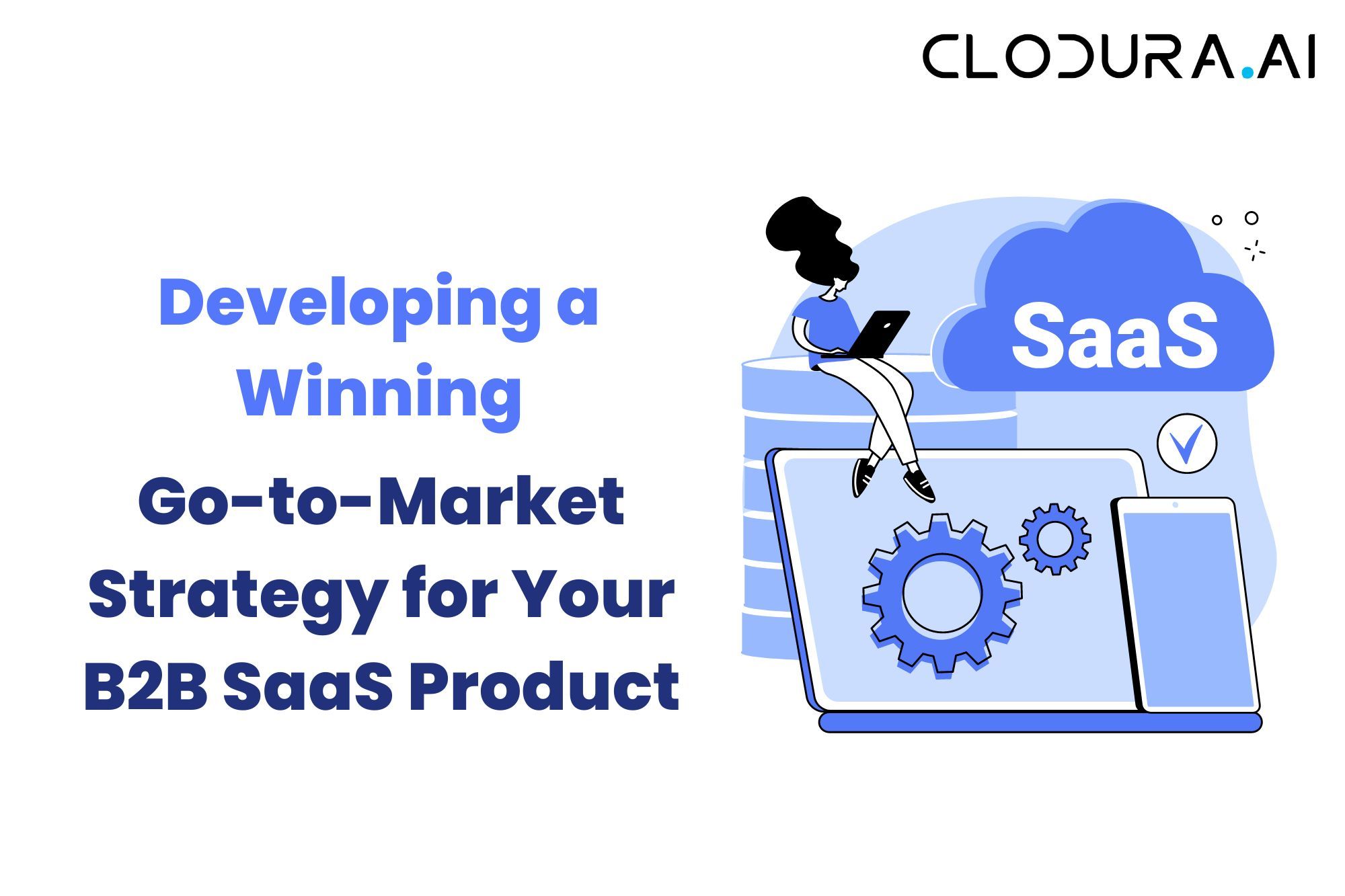Go-to-Market Strategy B2B SaaS
If you're looking to bring your B2B SaaS product to market, it's crucial to have a well-defined go-to-market strategy.
In this blog, we'll go through the essential steps involved in creating a successful go-to-market plan for your B2B SaaS product. From identifying your target audience to measuring the impact of your strategy, we've got you covered.
Read on to learn how to develop and execute a winning B2B SaaS go-to-market strategy.
Defining Your B2B SaaS Go-to-Market Strategy
The world of B2B SaaS can be a crowded and competitive space, making it crucial for businesses to have a well-defined go-to-market strategy.
A go-to-market strategy is a comprehensive plan that outlines how a company will reach its target customers and achieve its business goals.
The first step in creating your B2B SaaS go-to-market strategy is to define your goals and objectives. This includes identifying what you want to achieve through your go-to-market plan.
Are you looking to acquire more customers, increase revenue, or break into a new market? By having a clear understanding of your objectives, you can begin to design a plan that works towards achieving them.
Once you have identified your goals, it's important to conduct a thorough analysis of your target market. This includes understanding your potential customers' needs, pain points, and buying behaviors. By having a deep understanding of your target market, you can tailor your messaging and positioning to resonate with them.
At this stage, it's also important to define your unique selling proposition (USP). Your USP is what sets your product apart from the competition. It's the reason why potential customers should choose your product over alternatives.

Answering these questions will help you craft an effective messaging strategy for your B2B SaaS product.
In addition to defining your USP, it's important to consider your pricing strategy. This includes determining your pricing model, as well as your pricing tiers and options. Your pricing strategy should align with your business objectives and target market, while also being competitive within your industry.
Another key element of your go-to-market strategy is your distribution strategy. This includes identifying the channels through which you will reach your target customers.
Will you rely on direct sales, partnerships, or digital marketing? Having a clear understanding of your distribution strategy will help you allocate resources effectively and reach your target customers efficiently.
Finally, it's important to measure the success of your go-to-market strategy. This includes identifying key performance indicators (KPIs) and regularly tracking and analyzing your results. By doing so, you can make data-driven decisions and continuously improve your strategy over time.
Overall, creating a successful B2B SaaS go-to-market strategy requires a deep understanding of your target market, a clear definition of your goals and objectives, a well-crafted messaging strategy, a competitive pricing strategy, a thoughtful distribution strategy, and a commitment to measuring and optimizing your results.
Identifying the right audience for your B2B SaaS is a crucial step towards the success of your product. Understanding who your target audience is, what they need, and how they behave will help you design a product that meets their needs and a marketing strategy that resonates with them.
One way to identify your target audience is to analyze the decision-makers in the companies that are most likely to benefit from your product.
For example, if your B2B SaaS is a project management tool, your target audience could be project managers or team leaders in companies of a certain size or industry.
Understanding the job roles, pain points, and priorities of your target audience will help you craft messaging that speaks directly to them. Another important factor to consider when identifying your target audience is where they spend their time online.
Do they frequent certain social media platforms, industry forums, or news sites? Knowing where your audience spends their time will help you determine the best channels to reach them and the type of content that will be most effective in capturing their attention.
Market research is a valuable tool for identifying your target audience. Surveys can help you gather direct feedback from potential customers, while social media analysis can provide insights into the conversations and topics that are most relevant to your audience.
Competitor research can also help you understand the landscape of your industry and the needs of your target audience.
Once you have a clear understanding of your audience, you can tailor your messaging and outreach strategies to better reach them. This could include creating targeted ads, developing content that speaks directly to their pain points, or partnering with influencers or industry leaders who have a strong following among your target audience.
Overall, identifying the right audience for your B2B SaaS is a crucial step towards building a successful product and marketing strategy. By understanding your target audience's needs, behaviors, and preferences, you can create a product and messaging that resonates with them and drives growth for your business.
Crafting an Effective Messaging Strategy for B2B SaaS
An effective messaging strategy is a key component of any successful go-to-market plan. Your messaging should clearly communicate your USP, address pain points of your target audience, and differentiate your product from the competition. But how do you go about crafting an effective messaging strategy that resonates with your target audience and sets you apart from the competition?
First, you need to understand your target audience.
Who are they?
What are their pain points?
What motivates them to buy?
Once you have a clear understanding of your target audience, you can craft messaging that speaks directly to them.
Next, you need to clearly communicate your USP (Unique Selling Proposition).
What sets your product apart from the competition?
Why should a potential customer choose your product over someone else's?
Your messaging should clearly and succinctly communicate your USP.
It's also important to address any pain points your target audience may have.
What challenges do they face?
How does your product solve those challenges?
Your messaging should make it clear that your product is the solution to their problems.
But messaging isn't just about what you say, it's also about how you say it. Your messaging should be consistent across all channels. From your website to your social media channels and email campaigns, your messaging should be clear, concise, and on-brand. This consistency helps build trust with your target audience and reinforces your brand identity.
Finally, don't be afraid to test and iterate on your messaging. What works today may not work tomorrow. Continuously testing and refining your messaging can help ensure that it remains effective and resonates with your target audience.

When it comes to setting realistic goals for your B2B SaaS go-to-market plan, there are a few key factors that you need to take into consideration. One of the most important of these factors is your target market.
Who are you trying to reach with your product or service?
What are their needs and pain points?
Understanding your target market is essential to setting goals that are both achievable and relevant.
Another important factor to consider when setting goals for your B2B SaaS go-to-market plan is your competition.
What are your competitors doing?
How are they reaching their target market?
What are their strengths and weaknesses?
Understanding your competition can help you set goals that are not only realistic but also help you differentiate yourself from your competitors.
In addition to understanding your target market and competition, it's also important to consider your resources.
What is your budget?
How much time do you have to devote to your go-to-market plan?
What skills and expertise do you have on your team?
Setting goals that are achievable within your resources is key to ensuring that you don't become demotivated by unrealistic expectations.
Once you've taken these factors into consideration, it's time to set your SMART goals. Specific goals help you focus on what you want to achieve and how you're going to achieve it.
Measurable goals allow you to track progress and make adjustments as needed. Achievable goals ensure that you're setting yourself up for success, rather than failure. Relevant goals ensure that you're focusing on what's important to your business.
Time-bound goals help you stay on track and ensure that you're making progress towards your goals.
In summary, setting realistic goals for your B2B SaaS go-to-market plan is essential to your success. By understanding your target market, competition, and resources, and setting SMART goals, you can ensure that you're on the right track to achieving your business objectives.
Creating an Impactful Launch Plan for Your B2B SaaS
● Thoughtful Strategy: Plan a well-thought-out launch strategy to maximize the impact of your product launch.
● Launch Event: Host an engaging launch event to generate excitement and showcase your product to potential customers.
● Email Campaigns: Send targeted email campaigns to your subscriber list, highlighting the key features and benefits of your SaaS.
● Explainer Video: Create a compelling explainer video that clearly demonstrates the value proposition of your product.
● Social Media Campaign: Run a social media campaign to create buzz, engage with your audience, and drive traffic to your launch.
● Leverage Influencers: Collaborate with industry influencers, analysts, or bloggers to help amplify your message and reach a wider audience.
● Measure Results: Track and analyze the success of your launch plan to identify areas of improvement for future launches.
By implementing these strategies, you can enhance the impact of your B2B SaaS product launch and increase your chances of success in the market.

Maximizing Your B2B SaaS Product's Reach
After your product launch, it's essential to continuously work towards expanding your reach and acquiring new customers. One of the most effective ways to achieve this is through content marketing.
Creating value-added content such as blog posts, ebooks, white papers, or case studies can help establish your brand as an authority in the industry and attract more traffic to your website. Additionally, partnering with complementary businesses can help expand your product's reach and increase brand awareness.
Utilizing Social Media to Promote Your B2B SaaS
Social media is an integral part of any go-to-market strategy in today's digital age. Platforms like LinkedIn, Twitter, and Facebook offer unique opportunities to reach a wider audience of potential customers.
It's crucial to have a well-crafted social media strategy that includes creating engaging content, running ads, leveraging influencers, and responding to customer complaints or inquiries.
Leveraging Partnerships to Drive B2B SaaS Adoption
● Identify Complementary Businesses: Seek out businesses that cater to the same target audience but offer non-competing products or services.
● Win-Win Collaboration: Look for partnership opportunities that benefit both parties involved, creating a mutually beneficial relationship.
● Increased Visibility: Partnering with complementary businesses can expand your reach and expose your SaaS to a wider audience.
● Cross-Promotion: Collaborate on marketing initiatives, co-host webinars, or exchange guest blog posts to leverage each other's networks.
● Referral Programs: Establish referral programs with partners, incentivizing them to recommend your SaaS to their customers.
● Joint Case Studies: Showcase successful implementations by collaborating on case studies that highlight the value of your joint solution.
● Continuous Relationship Building: Nurture and maintain relationships with partners, exploring new opportunities for collaboration and growth.
By effectively leveraging partnerships, you can drive B2B SaaS adoption, increase brand visibility, and tap into new customer segments.
Establishing a Relationship Management Plan for B2B SaaS
Once you've acquired customers, it's important to maintain those relationships through effective relationship management. This includes regular communication, providing superior customer service, and offering ongoing value to your customers.
Creating a robust customer relationship management (CRM) plan can help you manage customers effectively, track interactions, and identify opportunities for upselling or cross-selling.
Measuring the Success of Your B2B SaaS Go-to-Market Strategy
Finally, it's crucial to measure the impact of your go-to-market strategy to determine its success. Tracking metrics like website traffic, customer acquisition cost, customer retention rate, and revenue growth can help you assess the effectiveness of your strategy.
Regularly reviewing your metrics and adjusting your strategy accordingly can help you stay on top of trends, identify new opportunities, and continuously improve your go-to-market plan.
To wrap up,
Developing a comprehensive go-to-market strategy is essential for any B2B SaaS product looking to succeed in today's competitive tech landscape. From identifying your target audience to crafting a compelling messaging strategy, launching your product, driving adoption, and measuring the impact of your strategy, every step of the process is crucial to achieving your goals and objectives.
By following the steps outlined in this blog and continuously iterating your approach based on feedback, you can create a successful B2B SaaS go-to-market strategy and grow your business.
FAQs
Q. What is a go-to-market strategy for B2B SaaS?
A go-to-market strategy is a plan outlining how a B2B SaaS company will reach its target customers and achieve its business goals.
Q. How do I define goals for my go-to-market strategy?
Identify your objectives, such as acquiring customers, increasing revenue, or entering new markets, to design a plan that aligns with your goals.
Q. How can I craft an effective messaging strategy?
Understand your target audience, communicate your unique selling proposition (USP), address pain points, ensure consistency, and continuously test and refine your messaging.
Q. Why is it important to identify the right audience for B2B SaaS?
Identifying the target audience helps design a product that meets their needs and a marketing strategy that resonates with them, driving growth for your business.
Q. How can partnerships drive B2B SaaS adoption?
Partnering with complementary businesses increases product visibility and attracts new customers, creating win-win situations and enhancing successful outcomes

